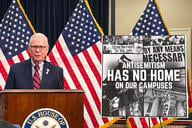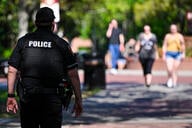You have /5 articles left.
Sign up for a free account or log in.
About 5 percent of students -- more than 1,000 students in total -- at the University of Kentucky experienced a sexual assault in the past year, according to the results of a new survey that researchers say could provide one of the most expansive looks yet at gender violence at an individual college.
Where many other campus surveys rely on responses from a sample of a few thousand students, Kentucky’s survey was sent to every student and the results include data from more than 24,300 respondents, or more than 80 percent of Kentucky's students. The survey will be conducted annually for at least four more years.
“This is what we must do as we undertake our sacred trust to care for the health and well-being of our students,” Eli Capilouto, Kentucky's president, said in a statement. “Because we surveyed the entire student population, we have a clearer understanding of our strengths and areas where we need to improve.”
Though all students were required to take the survey, about 5,000 did not participate in time for this preliminary round of data and students could opt out of certain questions if they felt uncomfortable answering them. Still, the number of respondents to the Kentucky survey dwarfs that of similar efforts, such as the recent survey at the University of Michigan that was sent to 3,000 students, or about 7 percent of students. The University of Texas System recently started conducting a large survey about campus sexual assault, as well. Like Michigan's, the study will select a sample size of students, but it will pull its respondents from every campus across the statewide system.
The results of the Michigan survey, released in June, found that about 11 percent of students experienced a sexual assault in the past year. About 22 percent of female undergraduate students and 7.6 percent of male undergraduate students said they had experienced a sexual assault in that time frame.
The report based on the Kentucky survey that was provided to Inside Higher Ed last week does not break the numbers down by gender, though the university said it will eventually release that data. Kentucky also used a narrower definition of sexual assault than Michigan’s and similar surveys that include unwanted kissing or sexual touching, and thus often show a higher percentage of students -- about one in five female students -- who say they have been assaulted.
“There are research studies that for very good reasons will broaden that definition because they want to understand the vast range of negative experiences students can have,” Diane Follingstad, executive director of Kentucky's Center on Violence Against Women, said. “That’s why we’re trying to very carefully show not only that these are our numbers, but here’s how we got them, exactly. It’s very important knowing what’s being assessed.”
The Kentucky survey asked students about “unwanted sexual experiences,” and defined that as completed or attempted intercourse, oral or anal sex, and used federal guidelines for defining physical force, threat of force and incapacitation. Kentucky's findings were similar to other surveys that have defined sexual assault in this way, including studies conducted by the U.S. Department of Justice and the Harvard School of Public Health.
The Kentucky survey found that 4.9 percent of students experienced an assault in the last year. That's 1,052 students who said they were assaulted, a far larger number than the 144 cases reported to university officials or the counseling center. More than 60 percent of the assaults occurred off campus and 27 percent occurred in university housing. About 6 percent occurred in what was designated as "UK affiliated off-campus" housing, which includes fraternity and sorority houses. Nearly three-quarters of students who were assaulted said the assault was committed by a fellow Kentucky student.
“We looked at that data a little more and most of the off-campus assaults appear to be happening in student houses or apartments,” Follingstad said. “It seems to be where people are living is where these things are happening. While many of them are not on campus, the vast majority are still committed by UK students.”
The survey also asked students about other kinds of intimate partner violence. Out of students who said they were in a relationship, 7.3 percent reported being physically abused and 17.2 percent reported “serious psychological abuse” from a partner.
Nearly one-quarter of students said they had been sexually harassed in the past year. The harassment included receiving unwanted sexual comments, messages, images, gestures and touching. More than 6 percent of students said they had been stalked.
In addition, students were asked about their perceptions of safety on campus and how the university responds to sexual assault. Nearly all students said they felt safe on campus during the day, and more than three-quarters said they felt safe at night. About 94 percent of students said they felt the university cares about their safety.
More than half of students said that sexual violence was a problem on campus. Generally, students said they had a positive perception of how the university handles sexual assault allegations, but half of the respondents said they worried about retaliation from other students if they were to report an assault.
A quarter of the surveyed Kentucky students were not aware that the university has both mandated reporters and confidential sources, or who on campus falls into each category. Almost 40 percent of students did not know that Kentucky officials must investigate claims of sexual assault or that the campus offered accommodations to victims, such as changing their dorm room assignment or moving them into a different class.
Michigan’s survey reached a similar conclusion: too few students are aware that their institution has policies about and resources dedicated to campus sexual assault.
“When I talk to campus police or Title IX officers, they say that ‘we do tell students about this and we give them this info,’” Follingstad said. “It’s talked about when they first arrive at UK, but there’s something about the way they’re getting the information that’s just not registering. We may need to find better ways to communicate, perhaps improving the way it’s presented on our websites. There’s something happening that’s saying we might need better modes of communicating this to students.”




